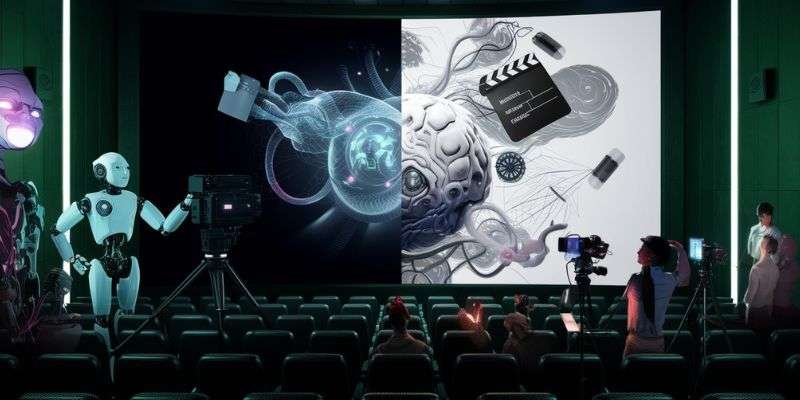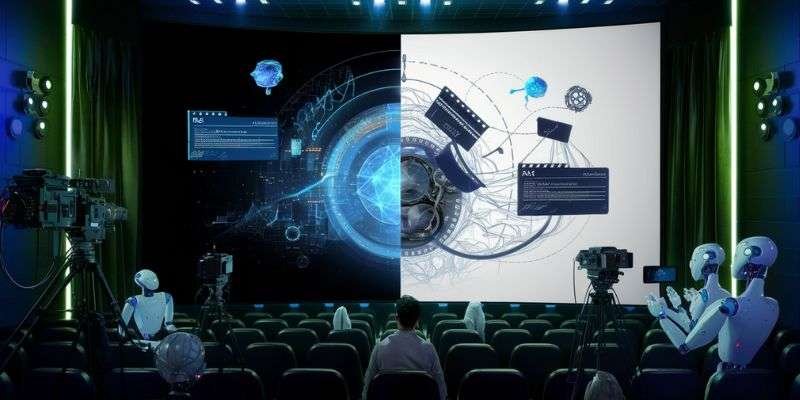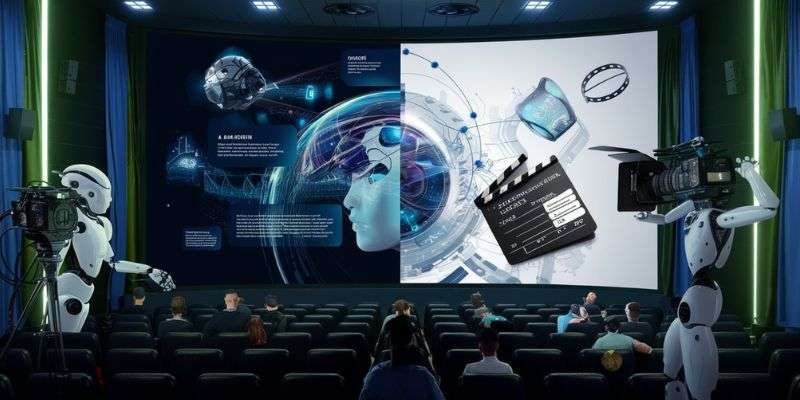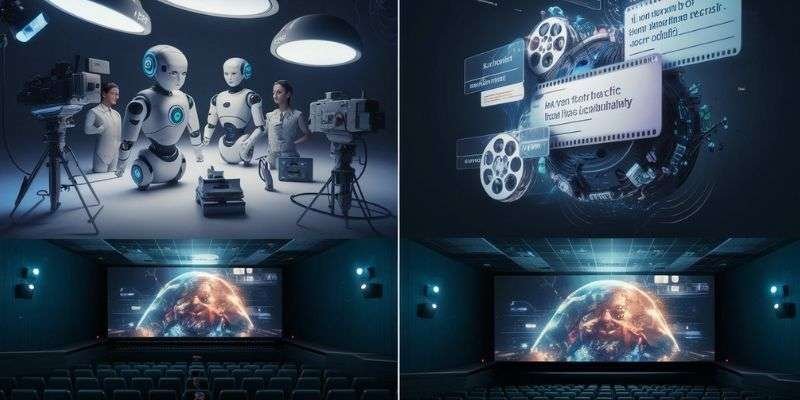
The realm of ai movie creation is rapidly evolving, revolutionizing the film industry with innovative tools and technologies. AI-powered movie makers are transforming how filmmakers approach their craft, offering new possibilities for storytelling, visual effects, and production efficiency. From generating scripts to creating stunning visuals, AI is becoming an indispensable tool in the filmmaker’s arsenal, enabling both novices and professionals to bring their creative visions to life with unprecedented ease and sophistication.
The Rise of AI in Filmmaking: Exploring AI Movie Generators and Creators

The integration of artificial intelligence into the world of filmmaking marks a significant turning point in the industry’s history. AI movie generators and creators are not just tools; they represent a paradigm shift in how we conceive, produce, and distribute cinematic content. This technological revolution is democratizing the filmmaking process, allowing creators with limited resources to produce high-quality content that was once the exclusive domain of well-funded studios.
Evolution of AI in the Film Industry
The journey of AI in filmmaking began with simple automated tasks and has rapidly evolved into sophisticated systems capable of assisting in nearly every aspect of movie production. Early applications of AI focused on streamlining post-production processes, such as color grading and sound mixing. However, as machine learning algorithms became more advanced, AI’s role expanded to include more creative aspects of filmmaking.
Today, AI can generate screenplay drafts, create storyboards, and even compose original music scores. This evolution has been driven by advancements in natural language processing, computer vision, and generative adversarial networks (GANs). These technologies enable AI systems to understand and mimic human creativity, opening up new possibilities for storytelling and visual artistry.
The impact of this evolution is profound. Filmmakers now have access to tools that can analyze successful movie formulas, predict audience reactions, and generate unique visual styles. This not only speeds up the production process but also allows for experimentation with narrative structures and visual techniques that might have been too risky or expensive to attempt otherwise.
Benefits and Challenges of AI in Filmmaking
The integration of AI into filmmaking brings a host of benefits that are reshaping the industry. One of the most significant advantages is the democratization of film production. AI tools make it possible for independent filmmakers and small studios to create content that rivals the production quality of major studios, leveling the playing field in an industry that has historically been dominated by big budgets.
AI also offers unprecedented efficiency in various stages of production. From automating time-consuming tasks like rotoscoping and background removal to generating realistic visual effects, AI can significantly reduce production time and costs. This efficiency allows filmmakers to focus more on the creative aspects of their work, potentially leading to more innovative and diverse content.
Moreover, AI’s ability to analyze vast amounts of data can provide valuable insights into audience preferences and market trends. This can help filmmakers make more informed decisions about content creation and marketing strategies, potentially increasing the chances of commercial success.
However, the rise of AI in filmmaking is not without challenges. One of the primary concerns is the potential loss of human creativity and artistic vision. Critics argue that over-reliance on AI could lead to formulaic and predictable content, lacking the unique perspectives and emotional depth that human creators bring to their work.
There are also ethical considerations to grapple with. As AI becomes more involved in the creative process, questions arise about copyright and authorship. Who owns the rights to a screenplay generated by AI? How do we attribute creative work that is a collaboration between human and machine?
Additionally, there are concerns about job displacement in the film industry. While AI creates new opportunities, it also automates tasks that were traditionally performed by skilled professionals. This shift could lead to significant changes in the workforce dynamics of the film industry.
Future Prospects of AI in Cinema
Looking ahead, the future of AI in cinema appears both exciting and transformative. As AI technologies continue to advance, we can expect even more sophisticated tools that blur the line between human and machine creativity. One potential development is the creation of fully AI-generated films, where algorithms handle everything from script writing to final editing.
We may also see the emergence of personalized movie experiences, where AI analyzes viewer preferences to create customized content in real-time. Imagine watching a film that adapts its plot, pacing, or even visual style based on your emotional responses or viewing history.
Virtual production, already revolutionized by AI, is likely to become even more advanced. We might see AI-powered systems that can generate entire virtual sets and characters in real-time, responding dynamically to actors’ performances and directors’ instructions.
AI could also play a crucial role in film preservation and restoration. Advanced algorithms could colorize black and white films, enhance old footage, or even recreate lost scenes based on existing data and historical context.
However, as these technologies progress, it will be crucial to strike a balance between technological innovation and human creativity. The most successful applications of AI in filmmaking will likely be those that enhance and augment human creativity rather than replace it entirely.
The rise of AI in filmmaking represents a new frontier in cinema, full of potential and challenges. As we navigate this evolving landscape, the key will be to harness the power of AI while preserving the human touch that makes cinema a powerful and emotive art form.
AI Movie Trailers and Posters: Generating Engaging Visuals with AI

In the ever-evolving landscape of film marketing, AI has emerged as a powerful tool for creating captivating movie trailers and posters. These visual elements play a crucial role in a film’s promotional strategy, serving as the first point of contact between the movie and its potential audience. The integration of AI in this process has opened up new avenues for creativity and efficiency, allowing filmmakers and marketers to generate engaging visuals that capture the essence of their films in innovative ways.
The Importance of Visuals in Film Marketing
Visual elements like trailers and posters are the cornerstone of film marketing, serving multiple critical functions in promoting a movie and attracting audiences. Their importance cannot be overstated in an industry where first impressions can make or break a film’s success.
Trailers and posters are often the first exposure potential viewers have to a film. They serve as a visual and emotional hook, providing a glimpse into the movie’s world, characters, and story. An effective trailer or poster can generate buzz, spark curiosity, and create anticipation for the film’s release. In today’s fast-paced digital environment, where attention spans are short and competition for eyeballs is fierce, these visual elements need to be compelling enough to make an immediate impact.
Moreover, trailers and posters play a crucial role in establishing the film’s genre and tone. Through careful selection of imagery, color schemes, and music (in the case of trailers), they communicate whether the film is a heart-pounding action thriller, a lighthearted romantic comedy, or a thought-provoking drama. This helps set viewer expectations and attracts the right target audience.
In the age of social media and viral marketing, visually striking posters and trailers have the potential to spread rapidly across various platforms. A well-crafted poster can become an iconic image associated with the film, while an intriguing trailer can spark online discussions and shares, amplifying the movie’s reach far beyond traditional advertising channels.
Financially, the impact of these visual elements is significant. A strong trailer or poster can drive pre-release ticket sales and generate interest from distributors and exhibitors. In many cases, the success of a film’s marketing campaign, heavily reliant on these visual components, can be as crucial to its box office performance as the quality of the film itself.
Technologies Behind AI-Generated Trailers and Posters
The creation of AI-generated movie trailers and posters involves a complex interplay of various cutting-edge technologies. These tools leverage the power of machine learning and data analysis to automate and enhance the creative process, resulting in visually compelling marketing materials.
- Deep Learning and Neural Networks: At the core of AI-generated visuals are deep learning algorithms, particularly Convolutional Neural Networks (CNNs) and Recurrent Neural Networks (RNNs). These networks are trained on vast datasets of existing movie trailers and posters, learning to recognize patterns, styles, and elements that make them effective.
CNNets analyze visual and auditory features, allowing the AI to generate eye-catching posters or engaging trailers that resonate with audiences. This technology transforms static designs into dynamic interpretations, giving marketers new tools to convey a film’s narrative in captivating ways.
- Natural Language Processing (NLP): Another significant component is Natural Language Processing, which aids in understanding scripts and dialogues. By parsing the screenplay, AI can identify key themes, character arcs, and pivotal moments to highlight in trailers or representative images. NLP enables the generation of concise, impactful titles and taglines that encapsulate a film’s essence while resonating with potential viewers.
- Style Transfer and Image Synthesis: AI also employs style transfer techniques, allowing for the integration of various artistic styles into the visuals. For example, an AI can take inspiration from famous artwork or iconic cinematic visuals to create unique movie posters that stand out in crowded markets. Coupled with image synthesis technologies, which enable the production of hyper-realistic graphics, filmmakers can craft striking visuals that take on a life of their own, becoming art pieces worthy of admiration beyond their functional roles in marketing.
These advanced AI technologies not only simplify the design process but also exponentially increase creative possibilities. They free human artists from technical constraints, letting them explore visionary ideas without the burden of laborious manual programs. Conversely, this compatibility between AI and human creativity represents a partnership rather than a replacement.
Examples of Notable AI-Generated Marketing Materials

The effectiveness of AI in creating trailers and posters can best be understood through notable examples that have made waves within the industry. These instances serve as a testament to how AI can achieve both artistic vision and commercial appeal, bridging the gap between art and technology.
Various AI-generated movie posters have gained traction on social media due to their unique aesthetics and fresh interpretations of traditional designs. One such example is the successful ‘生成电影’ (or ‘Generate Movie’) project, whereby AI-generated posters are designed in real-time during live events or screenings, engaging audiences instantly and providing a sense of belonging. The allure lies not just in the final product but in the act of creation itself, with fans witnessing the technology’s unfolding magic.
Moreover, several independent filmmakers have started employing AI tools to create trailers that captivate their niche audience. For instance, “Release the Beast,” an indie horror film, utilized AI models trained on previous horror film trailers to craft a gripping promotional piece that reflected its nightmarish themes without relying heavily on conventional production resources. The innovative approach went viral, earning them recognition and an enthusiastic following despite a lower budget.
In addition to this, major studios like Disney and Warner Bros. have begun exploring AI-driven strategies for clip selection in trailers. Utilizing algorithms to extract heart-pounding moments from their extensive libraries of footage has led to tailor-made clips that resonate deeply with specific target demographics, ensuring heightened viewer engagement leading up to release dates.
Through these examples, it’s evident that AI-generated marketing materials elevate the creative process while amplifying outreach potential. The marriage of technology and art brings forth innovation that keeps audiences eager and curious about what’s next in cinema.
Conclusion
The rise of AI in filmmaking presents a fascinating intersection between technology and creative artistry, particularly in areas like movie making, trailer production, and visual marketing. As AI tools continue to evolve and become increasingly accessible, they offer filmmakers exciting opportunities to enhance their stories and reach audiences like never before. Embracing these innovations could shape the future of cinema, where human ingenuity collaborates seamlessly with artificial intelligence, fostering a new era of creative exploration.
Leave a Reply